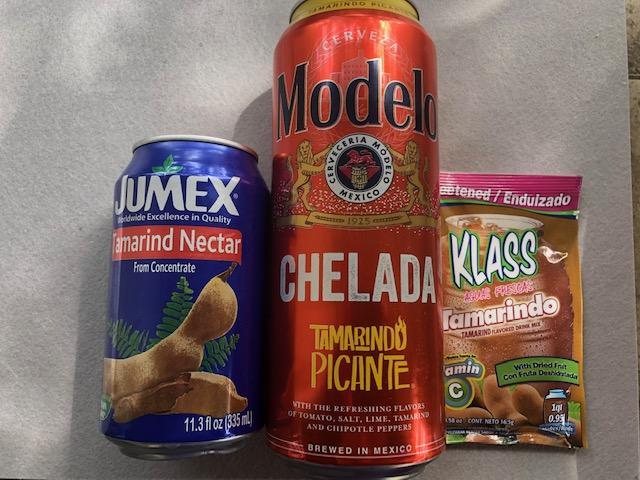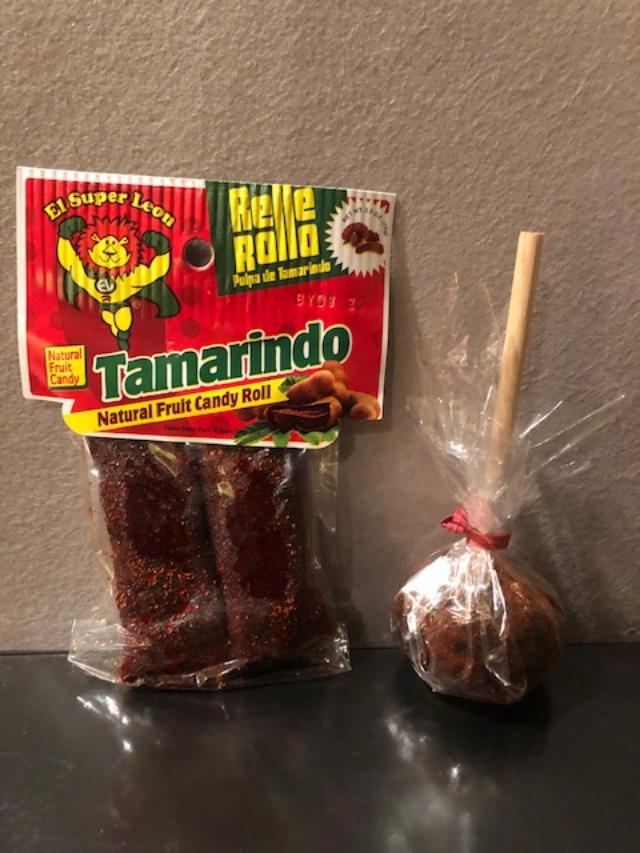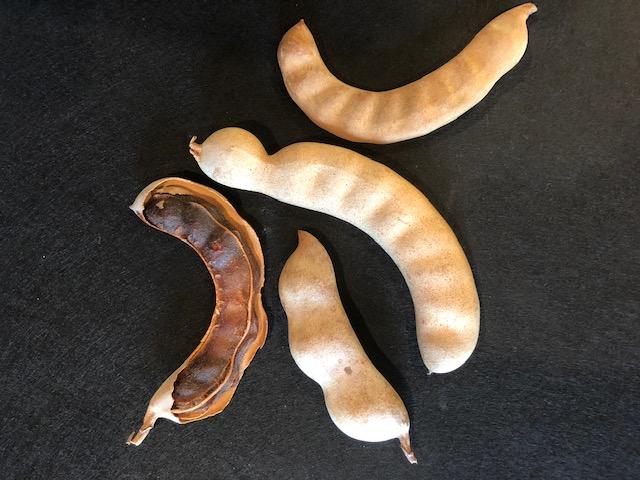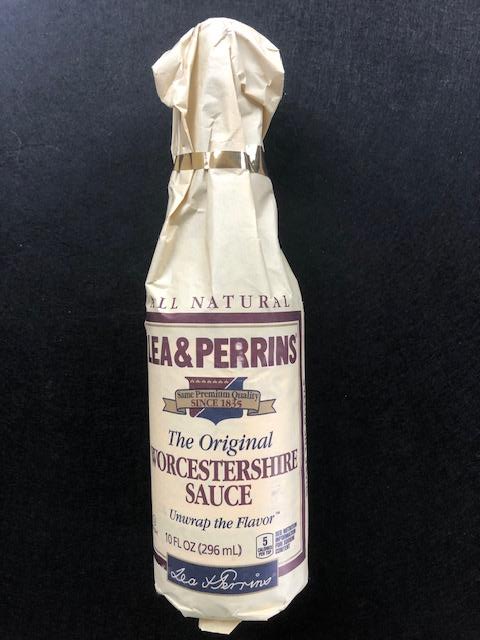By Maryann Readal
The tamarind tree (Tamarindus indica) is one of many tropical herbal trees. Its leaves, bark, wood, roots, and fruits have many uses. The tamarind tree  is also an evergreen, long-lived landscape tree, reaching a height of 40 to 60 feet tall and a width of up to 25 feet wide. Its pinnate leaves close up at night. The branches droop to the ground, making it a graceful shade tree. A mature tree can produce up to 350-500 pounds of fruit each year. It is native to tropical Africa and is in the Fabaceae family.
is also an evergreen, long-lived landscape tree, reaching a height of 40 to 60 feet tall and a width of up to 25 feet wide. Its pinnate leaves close up at night. The branches droop to the ground, making it a graceful shade tree. A mature tree can produce up to 350-500 pounds of fruit each year. It is native to tropical Africa and is in the Fabaceae family.
One of the earliest documented uses of tamarind was found in the Ganges Valley of India, where wood charcoal dating back to 1300 BCE was discovered. Tamarind was mentioned in ancient Indian scriptures as early as 1200 BCE. Arab physicians were reported to be the first to use the fruit pulp as medicine. It was the Arabs who named the tamarind, calling it “tamara hindi” or Indian date. It is thought that the Arabs were responsible for the spread of the tamarind through the Persian Gulf region and Egypt. There is documented use of tamarind in Egypt in 400 BCE. The tamarind was brought to the Americas by the Spanish in the 1600s. A tamarind tree was planted in Hawaii in 1797.
 The tamarind tree grows well in USDA Hardiness Zones 10-11 and therefore, is not commonly seen in the continental United States, except in southern Florida. It produces a showy light brown, bean-like fruit, which can be left on the tree for up to six months after maturing. The sweet-sour pulp that surrounds the seeds is rich in calcium, phosphorus, iron, thiamine, and riboflavin and is a good source of niacin. The pulp is widely used in Mexico to make thirst-quenching juice drinks and even beer. It is also very popular in fruit candies. The fruit is used in Indian cuisines in curries, chutneys, meat sauces, and in a pickle dish called tamarind fish. Southeast Asians combine the pulp with chiles and use it for marinating chicken and fish before grilling. They also use it to flavor sauces, soups, and noodle dishes. Chefs in the United States are beginning to experiment with the sweet-sour flavor of tamarind pulp. Did you know that tamarind is a major ingredient in Lea & Perrins® Worcestershire Sauce?
The tamarind tree grows well in USDA Hardiness Zones 10-11 and therefore, is not commonly seen in the continental United States, except in southern Florida. It produces a showy light brown, bean-like fruit, which can be left on the tree for up to six months after maturing. The sweet-sour pulp that surrounds the seeds is rich in calcium, phosphorus, iron, thiamine, and riboflavin and is a good source of niacin. The pulp is widely used in Mexico to make thirst-quenching juice drinks and even beer. It is also very popular in fruit candies. The fruit is used in Indian cuisines in curries, chutneys, meat sauces, and in a pickle dish called tamarind fish. Southeast Asians combine the pulp with chiles and use it for marinating chicken and fish before grilling. They also use it to flavor sauces, soups, and noodle dishes. Chefs in the United States are beginning to experiment with the sweet-sour flavor of tamarind pulp. Did you know that tamarind is a major ingredient in Lea & Perrins® Worcestershire Sauce?  The fruit pods are long-lasting and can be found in some grocery stores, especially those serving Hispanic, Indian, and Southeast Asian populations.
The fruit pods are long-lasting and can be found in some grocery stores, especially those serving Hispanic, Indian, and Southeast Asian populations.
All parts of this ancient tree have been used in traditional medicines in Africa and Asia and have a long list of maladies that they have treated. According to Purdue’s Horticulture and Landscape Architecture Department (https://www.hort.purdue.edu/newcrop/morton/tamarind.html), “Tamarind preparations are universally recognized as refrigerants in fevers and as laxatives and carminatives.” The ground-up seeds have been used as a poultice for boils, while the boiled leaves and flowers were used as poultices for sprains and swollen joints. The bark is astringent, tonic, and a fever reducer. An infusion of the roots has been used to treat chest complaints and leprosy. It has also been used to treat sunstroke, Datura poisoning, and alcohol intoxication. According to WebMD®, there is not sufficient evidence to determine the effectiveness of tamarind to treat most of these illnesses. However, research has shown that eye drops containing tamarind seed extract do improve dry eye.
Throughout the tropical world, there are many legends and superstitions regarding the tamarind tree. Here are a few:
- A Buddhist parable about tamarind seeds says that they are the symbol of faithfulness and forbearance.
- Some African tribes believe that the tree is sacred, and some Indians believe that one should not sleep under one because of the acid it “exhales” during the night.
- Some even believe that nothing will grow under a tamarind tree. However, Maude Grieve, in her 1931 book, A Modern Herbal, claimed that “some plants and bulbs bloomed luxuriantly under the tamarind trees in her garden in Bengal.”
- The Burmese believe that the tree is the dwelling place of the rain god, and that the tree raises the temperature of the ground beneath it.
- In Nyasaland, tamarind bark is soaked with corn and fed to livestock as a way of guaranteeing their return if they are lost or stolen.
- In some Asian countries, it is believed that evil spirits inhabit the tamarind tree and building a house where it grows should be avoided.
- In the Caribbean, old tamarind trees are believed to have spirits living in them.
The tamarind is an incredibly useful tree. The young leaves and shoots are eaten as a vegetable, and the flowers and leaves can be added to salads. The flowers are also important as a pollen source for bees. The leaves can be  used as fodder for domestic animals and food for silkworms. The leaves are also used as garden mulch.
used as fodder for domestic animals and food for silkworms. The leaves are also used as garden mulch.
The seeds are ground to make flour, or roasted and used as a coffee substitute or as an addition to coffee. The seeds are also processed to produce a natural pectin and food stabilizer. There are many more uses of the seeds that are too numerous to list.
The oil produced from the tamarind is culinary grade oil and is also used in specialty varnishes, adhesives, dyeing, and tanning.
The wood of the tamarind is another example of exceptional usefulness as it is very hard and insect resistant. It makes great handles for tools and is prized for furniture and paneling. It is considered a valuable fuel source because it gives off intense heat. The branches of the tamarind are used as walking sticks. The bark contains tannins and is used in tanning hides and is also used to make twine.
 The fruit pulp is useful as a dye fixative, or combined with sea water, it cleans silver, brass, and copper. In addition to all of these uses, school children in Africa use the seeds as learning aids in arithmetic lessons and as counters in traditional board games.
The fruit pulp is useful as a dye fixative, or combined with sea water, it cleans silver, brass, and copper. In addition to all of these uses, school children in Africa use the seeds as learning aids in arithmetic lessons and as counters in traditional board games.
The next time you reach for a bottle of Worcestershire sauce, remember the ancient tamarind tree and its usefulness in the tropical parts of our world.
Photo Credits: 1) Tamarindus indica (JIRCAS); 2) Tamarind-based beverages; 3) Tamarind-based confections; 4) Tamarind seed pods; 5) Lea & Perrins® Worcestershire sauce (Photos 2 – 5, courtesy of the author).
References
Ebifa-Othieno, Esther, et al. “Knowledge, attitudes and practices in tamarind use and conservation in Eastern Uganda. Journal of Ethnobiology & Ethnomedicine. Vol. 13. Jan. 2017. Available from Ebscohost. Accessed 10/16/20.
El-Siddiq, K., et al. Tamarind, Tamarindus indica. England, Southhampton Centre for Underutilized Crops, 2006. Available from Google Scholar. Accessed 10/18/20.
Grieve, Mrs. M. A Modern Herbal. Harcourt, Brace, & Company. 1931.
History of tamarind. Available from https://www.world-foodhistory.com/2011/07/history-of-tamarind.html. Accessed 10/16/20.
Missouri Botanical Garden. Plant Finder. Available at http://www.missouribotanicalgarden.org/plantfinder/plantfindersearch.aspx. Accessed 10/16/20.
Tamarind. Purdue University Horticulture and Landscape Department. Available from https://www.hort.purdue.edu/newcrop/morton/tamarind.html. Accessed 10/18/20.
Tamarind. WebMD. Available from https://www.webmd.com/vitamins/ai/ingredientmono-819/tamarind. Accessed 10/18/20
Tamarind tree. Available from https://www.permaculturenews.org/2009/02/20/tamarind-tree/. Accessed 10/16/20.
Medicinal Disclaimer: It is the policy of The Herb Society of America, Inc. not to advise or recommend herbs for medicinal or health use. This information is intended for educational purposes only and should not be considered as a recommendation or an endorsement of any particular medical or health treatment. Please consult a health care provider before pursuing any herbal treatments.
Maryann is the Secretary of The Herb Society of America and a Master Gardener. She is a member of The Society’s Texas Thyme Unit in Huntsville, TX. She gardens among the pines in the Piney Woods of East Texas.

